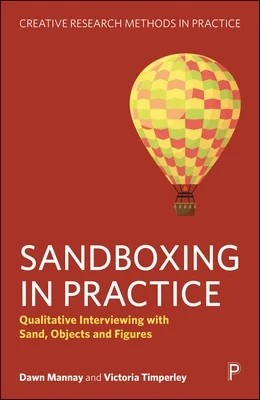When we are walking around with heavy, bright-blue bags that say Time to Play, filled with boxes of sand and hundreds of miniature figures, objects and miscellaneous items from shells to paperclips, social research may not be the first thing that springs to mind. It is more likely that our equipment is interpreted as a tool to engage the imaginations of children in an early-years setting – but our approach has proved invaluable in gaining an understanding of the perspectives of the communities with whom we work in our research studies.
Our sandboxing approach draws on the World Technique, developed by Margaret Lowenfeld as a projective therapeutic tool, where the intricacies of the child’s relational worlds can be transferred to the material provided for play. The World Technique consisted of boxes filled with sand and small objects representing things commonly found in a world, such as houses, trees, people, animals, transport, fences, lamp posts and street signs, as well as art-based materials, including coloured sticks, plasticine and glitter. Sandboxing involves similar equipment but is different from Lowenfeld’s World Technique in that it is not a therapeutic approach, but instead one that is focused on supporting qualitative research.
There have been objections to incorporating aspects of therapeutic and psychoanalytical practice in social research projects. It is important to draw distinctions between research and therapy and to ensure that ethics are centralised in the planning and implementation of all projects. However, it is not the equipment itself that is ethical or unethical but rather how it is used. Material objects in the form of photographs, collages, plasticine, pencils and paints are commonly featured in creative methods of data production, with an emphasis on an ethic of care. Sandboxing serves a similar purpose, and while the imaginative qualities of material objects and the freedom of creative approaches can sometimes take the researcher and participants on unexpected journeys, this can be attributed to the methods’ creative potentialities rather than their therapeutic associations.
We initially introduced sandboxing in 2013, in a study entitled University Challenge, which explored the experiences of mature undergraduates in higher education. Our first sandboxing kit was homemade, with a wooden drawer acting as the sand tray and a host of objects and figures taken from our children’s toys and items in our homes. We have since purchased more professional kits, but our original paraphernalia worked in much the same way. Participants engaged in building a representation of their experiences of entering higher education, the barriers faced, challenges negotiated and motivations to continue. They then shared the meanings that they attached to each object and how these acted as metaphors for their educational journeys. This elicitation interview is an important part of the process as it prioritises the participant’s subjective understandings, rather than the researcher’s interpretation of the sand scene.
Since this initial project with mature students, we and other researchers have used sandboxing in studies with Queer Latinx men, people with intellectual disabilities, parents, young people who have experienced debt, domestic abuse support workers, museum staff, care-experienced children, children transitioning to secondary school, children whose mothers are in prison and parentally bereaved children. This illustrates the suitability of the approach for diverse communities of different ages.
In our work with sandboxing, we have found that it enables participants to reflect on their experiences in the process of metaphorically representing aspects of their lives, facilitates conversations to be led by participants, and quietens the questioning research voice from intruding on what is important to communities in our studies. As well as creating sand scenes, participants sometimes play out scenarios by moving the figures, partially burying the objects or dividing and raising the sand to convey their narrative. There are also opportunities for reciprocal sandboxing when both researcher and participant make and share their representations in relation to a theme, and unlike some other techniques, no artistic or technological skills are necessary.
Like all approaches, sandboxing is not a one-size-fits-all, and participants should always be offered other ways to engage with a project. It is also important to provide materials that can represent and authentically connect with aspects of participants’ lives and their distinctive and diverse identities. Inclusivity can be an issue with commercially available sandboxing kits and researchers may need to supplement with additional figures and objects. Researchers also need to be attuned to participants’ preferences, emotions and ethics in situ.
Nonetheless, sandboxing has been effective in supporting participants to share their stories, perspectives and messages for change, and it is a method that we continue to use in research, teaching and to reflexively plan new projects. We have created a new guide to the approach – Sandboxing in Practice: Qualitative Interviewing with Sand, Objects and Figures – which will be useful for students, researchers and practitioners who want to explore creative ways to connect with communities and gain an understanding of their subjective experiences, aspirations, ideas and recommendations for policy and practice.
Dawn Mannay is Professor of Creative Research Methodologies at Cardiff University.
Victoria Timperley is Lecturer in Education at Cardiff University.
 Sandboxing in Practice by Dawn Mannay and Victoria Timperley is available on Policy Press for £14.99 here.
Sandboxing in Practice by Dawn Mannay and Victoria Timperley is available on Policy Press for £14.99 here.
Follow Transforming Society so we can let you know when new articles publish.
The views and opinions expressed on this blog site are solely those of the original blog post authors and other contributors. These views and opinions do not necessarily represent those of Bristol University Press and/or any/all contributors to this site.
Image credit: Steve Johnson via Unsplash


